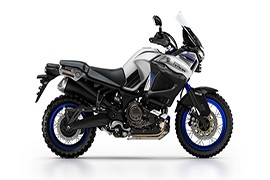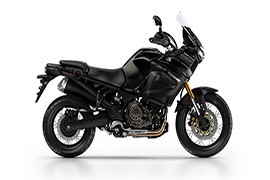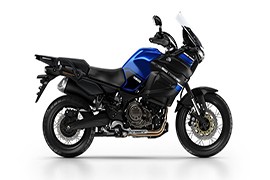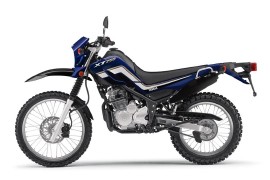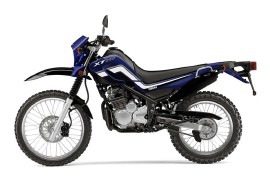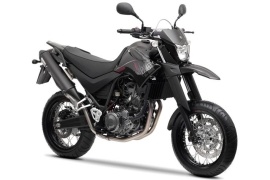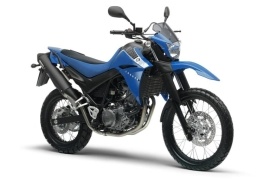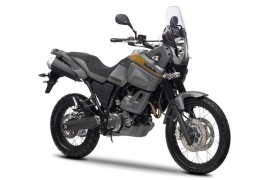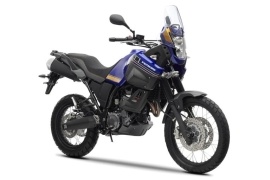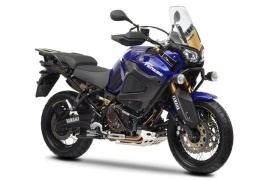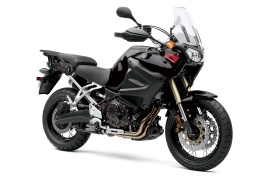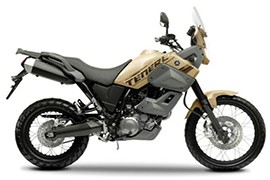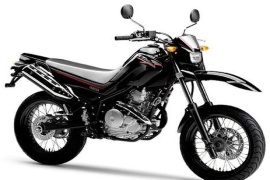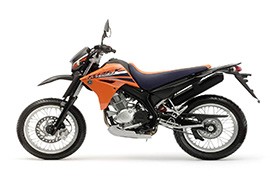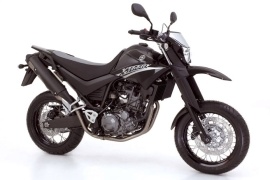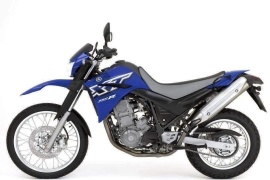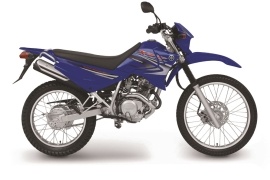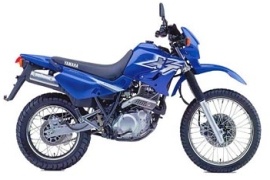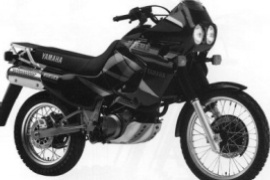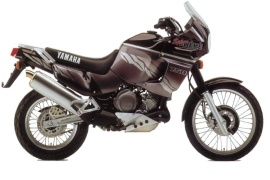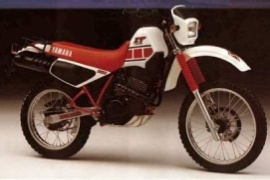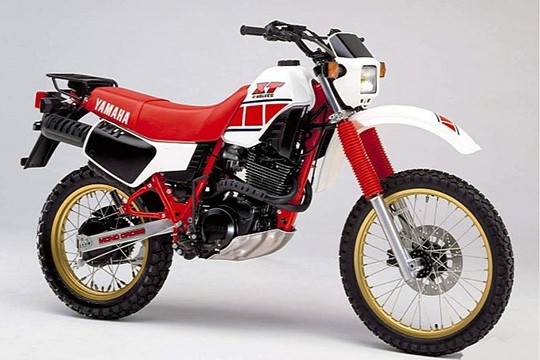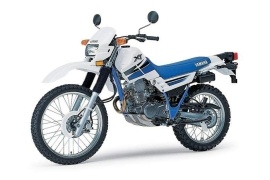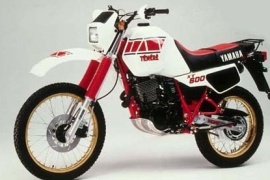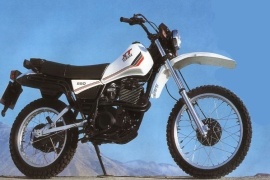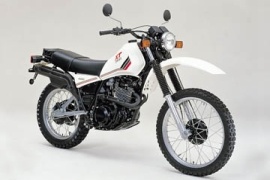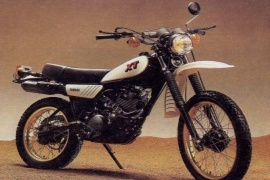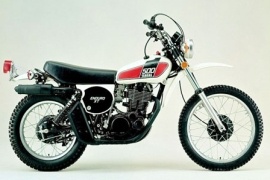YAMAHA XT Models/Series Timeline, Specifications & Photos
First production year: 1976
In 2018, alongside the base model, the Japanese motorcycle manufacturer launched the Yamaha XT 1200Z Super Tenere Worldcrosser, an adventure touring motorcycle packed with a set of goodies that beefed up and enhanced the performance of the stock model.
The 2018 Worldcrosser came with carbon fiber side panels and aluminum mesh protectors that gave the bike a unique appearance. Also, the plastic fork protectors were replaced by carbon fiber ones.
In addition, the bike was fitted with a set of stickers that pointed out its special package, letting riders know which one was the blessed model. Also, the fuel tank featured protection pads, increasing the grip while riding, standing, or seating.
As the bike was intended to run on rough terrain, the maker installed a shaft shield, a stronger skid plate, and a rear brake protector, all of which were made of anodized aluminum that enhanced durability.
The bike also had several optional features, including an Akrapovic exhaust system, fog lamps, a luggage system, engine guards, adjustable suspensions, heated grips, and a top case rack. These optional features were available as standard on the XT 1200ZE version.
In terms of power, the 2018 Yamaha XT 1200Z Super Tenere Worldcrosser had installed a 1,199cc four-stroke parallel-twin liquid-cooled engine that delivered an output power of 112 hp at 7,250 rpm and 117 Nm (86 lb-ft) torque at 6,000 rpm.
In 2018, the Japanese motorcycle manufacturer launched the Yamaha XT 1200Z Super Tenere, an adventure machine manufactured from the ground up as an exciting next-generation adventure tourer, combining Yamaha's Dakar-bred toughness and reliability with easy handling and lots of rider assist technologies.
The bike debuted in 2010 and was the largest dual-sports machine part of the XT series, named after the Tenere, a region in the south-central Shara. It featured a multi-mode Traction Control System (TCS), an Electronic Throttle Control (YCC-T) that supported off-road use, combined brakes with ABS, and switchable engine mapping.
In the aesthetic department, the motorcycle featured standard elements, such as a dual headlight system, a medium-sized windscreen, hand guards, a two-piece dual seat with passenger grab rails, a small luggage rack, and wire-spoke wheels.
All bits, pieces, and elements were mounted on a tube backbone steel frame. The frame was linked to a 43 mm inverted telescopic fork on the front and a link-type adjustable shock absorber on the rear, offering excellent suspension performance and handling.
The 2018 Yamaha XT 1200Z Super Tenere's power came from a 1,199cc four-stroke parallel-twin liquid-cooled engine with a fuel injection system in charge, delivering an output power of 112 hp at 7,250 rpm and 117 Nm (86 lb-ft) torque at 6,000 rpm.
The rear wheel was set in motion by a six-speed manual transmission with a wet multi-disc clutch and a final chain drive.
The Yamaha XT 1200Z Super Tenere was an adventure-touring motorcycle manufactured by Yamaha in 2010. It was the largest dual-sports machine of the XT series and was named after the Tenere, a region in the south-central Shara.
The bike was equipped with a multi-mode Traction Control System (TCS), an Electronic Throttle Control (YCC-T) that supported off-road use, combined brakes with ABS, and switchable engine mapping.
In 2018, the Japanese motorcycle manufacturer launched the Yamaha XT 1200ZE Super Tenere, a motorcycle fitted with everything a rider needs to leave the urban jungle and head to the horizon line.
The bike had standard features such as a half fairing, a dual headlight system, a medium-sized windscreen, hand guards, a two-piece dual seat with passenger grab rails, a small luggage rack, and wire-spoke wheels.
In the performance department, the 2018 Yamaha XT 1200ZE Super Tenere had installed a 1,199cc four-stroke parallel-twin liquid-cooled engine with a fuel injection system in charge, delivering an output power of 112 hp at 7,250 rpm and 117 Nm (86 lb-ft) torque at 6,000 rpm.
The bike was made around a tube backbone steel frame with a 43 mm inverted telescopic fork on the front and a link-type adjustable shock absorber on the rear, offering excellent suspension performance and handling.
The braking power was handled by two 310 mm wave discs on the front wheel and a 282 mm wave disc on the rear wheel, coupled to hydraulic calipers.
In 2017, the Japanese motorcycle manufacturer launched the Yamaha XT 250, a dual-sports motorcycle that featured the same technical, visual, and performance specifications as the previous model without any modifications whatsoever.
The Yamaha XT 250 was a dual-purpose motorcycle made by Yamaha over three generations. The first generation debuted in 1980 and was a staple of back roads and farms. The bike appeared in the 1982 First Blood movie ridden by Rambo.
The second-generation model debuted in 1984, and due to emission control considerations, the bike's output was reduced to 17 hp at 7,500 rpm. Also, the bike had redesigned plastics and a more compact fuel tank.
The bike was discontinued in 1991 and reintroduced in 2008 as a replacement for the Yamaha XT 225 due to 250cc class popularity. In 2013, the US model received a fuel injection system, delivering smoother power and fewer emissions.
The 2017 Yamaha XT 250 had standard features, such as a high-mounted front fender, a round headlight integrated into a small cowl, a one-piece dual seat with passenger grab handles, and wire-spoke wheels.
The bike's backbone was a semi-double-cradle steel frame with a 35 mm telescopic fork on the front and a single shock absorber on the rear, delivering optimum suspension performance and handling.
As for the braking power, the 2017 machine had fitted on its wheels a 245 mm disc on the front and a 203 mm disc on the rear, engaged by both front and rear hydraulic calipers.
The Yamaha XT 250 was a dual-sports motorcycle manufactured by Yamaha over three generations. The first generation debuted in 1980 and was a staple of back roads and farms. The bike appeared in the 1982 First Blood movie ridden by Rambo.
The second generation was released in 1984, and due to emission control considerations, the bike's output was reduced to 17 hp at 7,500 rpm. Also, the bike had redesigned plastics and a more compact fuel tank.
In the third generation, the bike was discontinued in 1991 and reintroduced in 2008 as a replacement for the Yamaha XT 225 due to 250cc class popularity. In 2013, the US model was blessed with a fuel injection system.
In 2016, the Japanese motorcycle manufacturer launched the Yamaha XT-250, a dual-purpose motorcycle perfect for the urban jungle but also capable of handling back roads and off-road trails.
In the visual department, the bike had standard features, such as a high-mounted front fender, a round headlight integrated into a small cowl, a one-piece dual seat with passenger grab handles, and wire-spoke wheels.
The bike was built around a semi-double-cradle steel frame with a 35 mm telescopic fork on the front and a single shock absorber on the rear, delivering optimum suspension performance and handling.
The braking performance was handled by a 245 mm disc on the front wheel and a 203 mm disc on the rear wheel, engaged by both front and rear hydraulic calipers.
The Yamaha XT 660 was a dual-purpose motorcycle released as a replacement model for the Yamaha XT 600. The bike was powered by a 660cc liquid-cooled single-cylinder engine and was suitable for both paved and unpaved trails.
Alongside the base model, Yamaha manufactured two other versions, including a more street-oriented supermoto named XT 660X and an adventure-touring version designated as Yamaha XT 660Z Tenere.
In 2012, the Japanese motorcycle manufacturer launched the Yamaha XT 660X, a street-oriented motorcycle with a crisp response to throttle movement, steering, and modern allure.
The bike was equipped with standard features, such as a single headlight unit integrated into a small cowl acting as a wind deflector, a high-mounted front fender, a one-piece dual seat with passenger grab rails, a two-into-two exhausts system with a silencer on each side, and lightweight wire-spoke wheels.
The bike's wheels were fitted with a 320 mm disc engaged by a four-piston caliper on the front and a 245 mm disc tied to a single-piston caliper on the rear, delivering optimum braking performance.
In the performance department, the 2012 Yamaha XT 660X had its soul brought to life by a 660cc four-stroke liquid-cooled single-cylinder engine with a fuel injection system in charge, delivering 48 hp at 6,000 rpm and 60 Nm (44 lb-ft) torque at 5,250 rpm.
The Yamaha XT 660R was a dual-purpose motorcycle manufactured by Yamaha as a replacement for the XT 600 and a development of the original XT series, inspired by those motorcycles used in the Paris Dakar rally.
Alongside the XT 660R, the Japanese maker also made available the XT 660X, a more street-oriented motorcycle, and the XT 660Z Tenere, an adventure touring model. All bikes packed the same power unit and shared some chassis components.
In 2012, the Japanese motorcycle manufacturer launched the Yamaha XT 660R, an enduro-capable machine with excellent maneuverability, handling both urban trails and off-road tracks.
In the visual department, the bike had standard features, such as a high-mounted front fender, a single headlight, a small wind deflector, a one-piece dual seat with passenger grab handles, a high-mounted exhaust system, and wire-spoke wheels.
The bike's backbone was a diamond-shaped steel tube frame with a 43 mm telescopic fork on the front, providing 225 mm of travel, and a monocross system on the rear with 200 mm of travel, delivering optimum suspension performance.
The 2012 Yamaha XT 660R had installed a 660cc four-stroke liquid-cooled single-cylinder engine managed by a fuel injection system, boasting 48 hp at 6,000 rpm and 60 Nm (44 lb-ft) torque at 5,250 rpm.
The power was handled by a five-speed manual transmission with a wet multi-disc clutch and sent to the rear end through a final chain drive, spinning the rear wheel to a top speed of 165 kph (102 mph).
The Yamaha XT 660Z Tenere was a dual-sports motorcycle made by the Japanese bike maker Yamaha from 2008 until 2016. The bike had its heartbeat set by a 660cc single-cylinder engine produced by Minarelli. The XT 660R, XT 660X, MT-03, Jawa 660 Sportard, Jawa 660 Vintage, and Aprilia Pegaso 650 Trail also used the engine.
In 2012, alongside the standard model, the Japanese motorcycle manufacturer launched the Yamaha XT 660Z Tenere ABS, a motorcycle that packed the exact specifications as the base model, but as its name says, it featured an additional safety feature in the form of ABS.
In the visual department, the bike was identical to the base model, packing standard features, such as a single headlight unit, a small windscreen, an engine cover, side covers, a one-piece dual seat with passenger grab rails, a high-mounted exhaust system, and wire-spoke wheels.
The 2012 Yamaha XT 660Z Tenere ABS's power came from a 659cc four-stroke single-cylinder liquid-cooled engine fed by a fuel injection system, boasting 48 hp at 6,000 rpm and 58 Nm (43 lb-ft) torque at 5,250 rpm.
The bike's braking performance was handled by two 298 mm discs coupled to a dual-piston caliper mounted on the front end and a 245 mm disc with a single-piston caliper fitted on the rear wheel, delivering optimum stopping power, enhanced by Anti-Lock Braking System (ABS).
In 2012, the Japanese motorcycle manufacturer released the Yamaha XT 660Z Tenere, a motorcycle that packed the same technical, visual, and performance specifications as the previous model without any significant modifications whatsoever.
The Yamaha XT 660Z Tenere was a dual-sports motorcycle manufactured by Yamaha from 2008 until 2016. The bike was powered by a 660cc single-cylinder engine made by Minarelli. The XT 660R, XT 660X, MT-03, Jawa 660 Sportard, Jawa 660 Vintage, and Aprilia Pegaso 650 Trail also used the engine.
It was fitted with factory-installed standard features, such as a single headlight unit, a small windscreen, an engine cover, side covers, a one-piece dual seat with passenger grab rails, a high-mounted exhaust system, and wire-spoke wheels.
As for the power figures, the 2012 Yamaha XT 660Z Tenere had installed a 659cc four-stroke single-cylinder liquid-cooled engine that delivered 48 hp at 6,000 rpm and 58 Nm (43 lb-ft) torque at 5,250 rpm.
Suspension-wise, the 2012 XT 660Z Tenere has a 43 mm telescopic fork on the front, providing 210 mm of travel, and a monocross system on the rear with 200 mm of travel, delivering optimum suspension performance and handling.
The bike's braking performance was achieved by two 298 mm discs coupled to a dual-piston caliper mounted on the front end and a 245 mm disc with a single-piston caliper fitted on the rear wheel, delivering optimum stopping power.
The Yamaha XT 1200Z Super Tenere was an adventure touring motorcycle that debuted in 2010 as the largest dual-sports motorcycle in the XT series. The bike was named after Tenere, a desert region in south-central Sahara.
The bike was fitted with a multi-mode Traction Control System (TCS), an electronic throttle (YCC-T) with off-road supported programs, switchable engine mapping, and combined brakes with Anti-Lock Braking System (ABS).
In 2012, the Japanese motorcycle manufacturer launched the Yamaha Super Tenere Worldcrosser, a long-distance touring machine packed with modern technology and safety equipment.
In the visual department, the bike had standard features, including a dual headlight system, a medium-sized windscreen, a two-piece dual seat with passenger grab handles, a small luggage system, and lightweight wire-spoke wheels.
The bike was built around a steel frame with a 43 mm adjustable inverted telescopic fork on the front and an adjustable shock absorber on the rear, delivering excellent suspension performance and handling capabilities.
As for the braking power, the bike's wheels were fitted with two 310 mm wave discs on the front and a 282 mm wave disc on the rear, all coupled to hydraulic calipers, delivering excellent stopping performance.
In the power department, the 2012 Yamaha Super Tenere Worldcrosser had its soul brought to life by a 1,199cc four-stroke two-cylinder liquid-cooled engine with 110 hp at 7,250 rpm and 114 Nm (84 lb-ft) torque at 6,000 rpm.
In 2012, the Japanese motorcycle manufacturer launched the Yamaha XT 1200Z Super Tenere, an adventure motorcycle with the same package as the previous model, without any modifications whatsoever.
The Yamaha XT 1200Z Super Tenere was an adventure-touring motorcycle that debuted in 2010. It was the largest dual-sports motorcycle in the XT series and was named after the region in the south central Sahara.
Like the previous model, the 2012 motorcycle packed the same standard features, such as a dual-headlight system, a medium-sized windscreen, a two-piece dual seat, a high-mounted exhaust system, an engine plate, and wire-spoke wheels with road tires.
In the performance department, the 2012 Yamaha XT 1200Z Super Tenere took its force from a 1,199cc four-stroke parallel-twin liquid-cooled engine, boasting an output power of 110 hp at 7,250 rpm and 114 Nm (84 lb-ft) torque at 6,000 rpm.
The bike's power was handled by a six-speed manual transmission and sent to the rear wheel through a final shaft drive, pushing the motorcycle to 192 kph (120 mph).
All the bike's bits, pieces, and elements were bolted to a steel frame with a 43 mm fully adjustable telescopic fork on the front and an adjustable shock absorber on the rear, delivering excellent suspension performance and handling.
As for the braking power, the machine packed two 310 mm discs on the front and a 282 mm disc on the rear, operated by hydraulic calipers, offering excellent stopping power enhanced by an Anti-Lock Braking System.
The Yamaha XT 1200Z Super Tenere was an adventure touring motorcycle that debuted in 2010 as the largest dual-sports motorcycle in the XT series, named after the region in the south central Sahara.
The bike had a multi-mode Traction Control System (TCS), an Electronic Throttle Control (YCC-T) that supported off-road use, switchable engine mapping, and Combined Brakes with ABS.
In the visual department, the bike had standard features, such as a dual-headlight system, a medium-sized windscreen, a two-piece dual seat, a high-mounted exhaust system, an engine plate, and wire-spoke wheels with road tires.
The bike was manufactured around a steel frame with a 43 mm fully adjustable telescopic fork on the front and an adjustable shock absorber on the rear, delivering excellent suspension performance and handling.
The braking power was handled by two 310 mm discs with hydraulic calipers on the front and a 282 mm disc with a hydraulic caliper on the rear, offering excellent stopping power enhanced by an Anti-Lock Braking System.
As for the power figures, the 2011 Yamaha XT 1200Z Super Tenere had its heartbeat set by a 1,199cc four-stroke parallel-twin liquid-cooled engine that delivered an output power of 110 hp at 7,250 rpm and 114 Nm (84 lb-ft) torque at 6,000 rpm.
The power was transferred to a six-speed manual transmission and sent to the rear wheel through a final shaft drive, pushing the motorcycle to 192 kph (120 mph).
The Yamaha XT 660Z Tenere was a dual-sports motorcycle manufactured by Yamaha from 2008 until 2016. The bike was powered by a 660cc single-cylinder engine made by Minarelli. The XT 660R, XT 660X, MT-03, Jawa 660 Sportard, Jawa 660 Vintage, and Aprilia Pegaso 650 Trail also used the engine.
In 2008, the Japanese motorcycle manufacturer launched the Yamaha XT 660Z Tenere, a bike part of the XT series in Yamaha's range that debuted in 2008 and continued production until 2016.
In the aesthetic department, the 2008 Xt 660Z Tenere had standard features, such as a single headlight unit, a small windscreen, an engine cover, side covers, a one-piece dual seat with passenger grab rails, a high-mounted exhaust system, and wire-spoke wheels.
The bike was built around a diamond-shaped steel tube frame with a 43 mm telescopic fork on the front, providing 210 mm of travel, and a monocross system on the rear with 200 mm of travel, delivering optimum suspension performance and handling.
The braking power was achieved by two 298 mm discs coupled to a dual-piston caliper mounted on the front end and a 245 mm disc with a single-piston caliper fitted on the rear wheel, delivering optimum stopping power.
In the performance department, the 2008 Yamaha XT 660Z Tenere had installed a 659cc four-stroke single-cylinder liquid-cooled engine that delivered 48 hp at 6,000 rpm and 58 Nm (43 lb-ft) torque at 5,250 rpm.
The Yamaha XT 660 was a dual-purpose motorcycle that debuted as a replacement model for the Yamaha XT 600. The bike was powered by a 660cc liquid-cooled single-cylinder engine and was suitable for both paved and unpaved trails.
Alongside the XT 660 model, Yamaha produced two other versions, including a more street-oriented supermoto named XT 660X and an adventure-touring version designated as Yamaha XT 660Z Tenere.
In 2006, the Japanese motorcycle manufacturer launched the Yamaha XT 660X, a dual-purpose motorcycle that featured the same specifications as previous models without any significant modifications whatsoever.
The 2006 Yamaha XT 660X had installed a 659cc four-stroke liquid-cooled single-cylinder engine managed by a fuel injection system. As for the power figures, the power unit provided 48 hp with a peak force at 6,000 rpm and 58 Nm (43 lb-ft) torque at 5,250 rpm.
Holding the engine, a steel tubular diamond frame was fitted with a 43 mm telescopic fork on the front end, providing 225 mm of travel, and a monocross suspension system on the rear, delivering 200 mm of travel and handling the bike's suspension.
As for the braking power, the bike relied on a 320 mm disc grabbed by a four-piston caliper on the front wheel and a 245 mm disc managed by a single-piston caliper on the rear wheel, delivering optimum braking performance.
The Yamaha XT 250 Serow was a small-displacement dual-sports motorcycle that debuted in 1980. The bike was known as the XT 250 Serow in Japan and the XT 250 worldwide. One model was ridden by Rambo in the 1982 First Blood movie.
Also, its larger XT 500 sister appeared in several exciting stunt scenes in the 1981 James Bond film For Your Eyes Only. The bike was built over three generations and remained largely unchanged.
The final Serow model was released in 2020 in Japan, dropping the model from production due to increasing emission requirements.
In 2006, the Japanese motorcycle manufacturer launched the Yamaha XT 250 Serow, a versatile dual-sports motorcycle with great performance and ease of use, suitable for both paved or unpaved roads.
The 2006 motorcycle packed standard features, such as a high-mounted front fender, a small rectangular headlight integrated into a small cowl, a one-piece dual seat, a high-mounted exhaust system, and wire-spoke wheels with road tires.
The motorcycle packed a leading axle fork, a drum braking unit on the front, a single Kayaba shock absorber, and a drum braking unit on the rear, delivering optimum suspension performance and stopping power.
As for the power figures, the 2006 Yamaha XT 250 Serow had installed a 249cc four-stroke single-cylinder air-cooled engine that delivered an output power of 21 hp at 6,500 rpm and 20 Nm (15 lb-ft) torque at 6,500 rpm.
Yamaha XT 125X is a supermotard bike build in 2005 and take the styling from the popular XT 660 X. This bike has the same engine, frame and bodywork as the XT 125R. Powered by a carburetor, air-cooled, single-cylinder, SOHC four-stroke motor, Yamaha has strangled the power output to 10 hp, which makes performance less than impressive. Power is delivered smoothly, though and the five-speed gearbox is nice and slick.
In 2004, the Japanese motorcycle manufacturer launched the Yamaha XT 660X, a motorcycle produced alongside the XT 660R racing motorcycle. Both motorcycles packed the same engine and shared some chassis components.
The bike was fitted with standard features, such as a high-mounted front fender, a single headlight, a small front cowl with a tiny windscreen, a one-piece dual seat with passenger grab handles, a dual exhaust system with a silencer on each side, and wire-spoke wheels with road tires.
The bike was built around a steel tubular diamond frame with a 43 mm telescopic fork on the front end, providing 225 mm of travel, and a monocross suspension system on the rear, delivering 200 mm of travel.
In the braking department, the XT 660X had installed a 320 mm disc grabbed by a four-piston caliper on the front wheel and a 245 mm disc managed by a single-piston caliper on the rear wheel, delivering optimum braking performance.
In the performance department, the 2004 Yamaha XT 660X had installed a 659cc four-stroke liquid-cooled single-cylinder engine managed by a fuel injection system. As for the power figures, the power unit provided 48 hp with a peak force at 6,000 rpm and 58 Nm (43 lb-ft) torque at 5,250 rpm.
The power produced by the engine was sucked into a five-speed manual transmission with a wet multi-plate clutch and sent to the rear end through a final chain drive.
The Yamaha XT 660 was a dual-sports motorcycle manufactured by Yamaha as a replacement for the XT 600. The bike was a development of the original XT series, inspired by those motorcycles used in the Paris Dakar Rally.
In 2004, the Japanese motorcycle manufacturer launched the Yamaha XT 660R, a standard Enduro model with an R designation, where R stands for racing. The bike was powered by a 600cc liquid-cooled engine fed by a fuel injection system, delivering smooth power.
In the visual department, the bike had standard features, such as a high-mounted front fender, a small headlight integrated into a small cowl with a small wind deflector, a one-piece dual seat, a dual high-mounted exhaust system, and wire-spoke wheels.
The motorcycle was built around a tubular diamond steel frame with a 43 mm telescopic fork on the front, offering 225 mm of travel, and a monocross suspension system on the rear, delivering 200 mm wheel travel.
The bike's wheels were equipped with a 298 mm disc tied to a dual-piston caliper on the front and a 245 mm disc with a single-piston caliper on the rear, providing optimum stopping power.
As for the power figures, the 2004 Yamaha XT 660R had its soul brought to life by a 659cc four-stroke single-cylinder liquid-cooled engine, boasting 48 hp with a peak force at 6,000 rpm and 58 Nm (43 lb-ft) torque at 5,250 rpm.
From dusk until dawn, our latest farm workhorse is ready, willing and able. Built Yamaha tough and tested on South Island stations, the XTZ 125 is a dependable all-rounder on the farm and comes packed with effort saving electric start, a useful rear rack and a low maintenance air filter system. Whether your day leads you to public roads or narrow hillside tracks, the road legal 124cc four stroke XTZ 125 is the right tool for the job. The compact design, comfortable low seat and LCD instrument panel make the XTZ 125 the ideal multi-purpose bike for farms.
The Yamaha XT 600 was a motorcycle manufactured by Yamaha from 1984 until 2003. The bike replaced the XT 550 and featured design changes but also a downgrade of the fuel tank, shrinking it to 11.5 liters from a long-range 30-liter tank used by the 600ZL Teneres model.
In 1999, the Japanese motorcycle manufacturer launched the Yamaha XT 600, which was designated as the Yamaha XT 600E, packing the same features as the previous model with several modifications.
In the aesthetic department, the 1999 XT 600 was equipped with standard features, such as a high-mounted front fender, a small rectangular headlight integrated into a small cowl, a one-piece dual seat, engine bars, a high-mounted exhaust system, and lightweight wire-spoke wheels.
Suspension-wise, the motorcycle packed a 41 mm oil-damped telescopic fork on the front with 225 mm of travel and a preload-adjustable mono-cross suspension system with 220 mm of travel, offering optimum suspension performance and handling.
As for the braking performance, the bike relied on a 267 mm disc with a dual-piston caliper on the front wheel and a 220 mm disc tied to a single-piston caliper on the rear wheel, offering optimum stopping performance.
The 1999 Yamaha XT 600 had its soul brought to life by a 595cc four-stroke single-cylinder air-cooled engine fed by a single carburetor, delivering an output power of 45 hp at 6,500 rpm and 50 Nm (37 lb-ft) torque at 5,500 rpm.
The Yamaha XTZ 660 Tenere was a dual-sports motorcycle manufactured by Yamaha from 1991 until 1999. The bike was named after the Tenere desert stage of the previous Paris Dakar Rally held in northeastern Niger.
The motorcycles manufactured between 1991 and 1993 were fitted with a small rectangular headlight, while the ones produced from 1994 were equipped with two small round headlights. Also, the performance obtained during the 1990s Dakar editions provided an excellent reputation for the XTZ series.
In 1991, the Japanese motorcycle manufacturer launched the Yamaha XTZ 660 Tenere, a dual sports motorcycle that followed Yamaha's tradition, incorporating the latest engine and frame technology.
Aesthetically, the bike was fitted with standard features, such as a half fairing with a small rectangular headlight, a tiny windscreen, a one-piece dual seat, a small luggage rack with integrated passenger handles, a high-mounted exhaust system, an engine guard, and wire-spoke wheels.
In the performance department, the 1991 Yamaha XTZ 660 Tenere had installed a 660cc four-stroke liquid-cooled single-cylinder engine underneath its fuel tank, delivering an output power of 46 hp at 6,000 rpm and 57 Nm (42 lb-ft) torque at 5,000 rpm.
In the braking department, the bike relied on a 282 mm disc coupled to a four-piston caliper on the front wheel and a 245 mm disc with a single-piston caliper on the rear wheel, delivering optimum stopping power.
The Yamaha XTZ 750 Super Tenere was a dual sports motorcycle manufactured by Yamaha since 1989. The bike was named after lighter, single-cylinder Yamaha models, which were named after the Tenere desert stage of the former Paris Dakar Rally.
Compared to the Yamaha XTZ 660 Tenere, the XTZ 750 Super Tenere was larger and packed a new Yamaha twin-cylinder engine design with five-valve heads protected by a guard.
In 1989, the Japanese motorcycle manufacturer launched the Yamaha XTZ 750 Super Tenere, a dual sports machine that continued production until 1996, after the Dakar version YZE750 won the Dakar race twice.
In the aesthetic department, the bike had standard features, such as two round headlights integrated into a half fairing, a small windscreen for better wind protection, a one-piece dual seat with passenger grab handles, an up-swept two-into-one exhaust system, and wire-spoke wheels.
The bike was built around a single cradle steel frame with a telescopic fork on the front and a monoshock absorber on the rear, providing excellent suspension performance and handling capabilities.
The braking power was handled by two 245 mm discs tied to dual-piston calipers on the front wheel and a 245 mm disc with a single-piston caliper on the rear wheel.
As for the power figures, the 1989 Yamaha XTZ 750 Super Tenere had installed a 749cc four-stroke liquid-cooled two-cylinder engine, delivering 70 hp at 7,500 rpm and 68 Nm (50 lb-ft) torque at 6,750 rpm.
The Yamaha XT 350 was an enduro motorcycle part of the XT series in Yamaha's range, manufactured from 1985 until 2000, almost unchanged. One modification included a reduced output power due to noise and emission regulations by mounting restricting plates in the intake tract.
Compared to the XT 600 model, the XT 350 was lighter but similar in design with a monocross suspension system and seating position. Due to its lightweight, the bike was well suited for off-road use but also longer journeys.
In 1985, the Japanese motorcycle manufacturer launched the Yamaha XT 350, the first model in the series, packing a 350cc engine and long travel suspension. Due to its mirrors, indicators, horn, headlight, tail light, and license plate holder, the bike was street-legal.
In the suspension department, the XT 350 packed a telescopic fork on the front and a mono-cross suspension system on the rear, providing optimum suspension performance and handling.
As for the braking power, the bike relied on a brake disc on the front wheel and a drum braking unit on the rear wheel, delivering optimum stopping power.
As for the power figures, the 1985 Yamaha XT 350 had its heartbeat set by a 346cc four-stroke single-cylinder air-cooled engine managed by a single carburetor, delivering 32 hp at 7,500 rpm and 29 Nm (22 lb-ft) torque at 7,000 rpm.
The engine was tied to a six-speed manual transmission that took the power and sent it to the rear wheel through a final chain drive.
The Yamaha XT 600 was an all-purpose motorcycle manufactured by Yamaha from 1984 until 2003 in several different versions. The bike could handle both paved and unpaved roads and represented a significant improvement over the 1975 Yamaha XT 500 model.
In 1984, the Japanese motorcycle manufacturer introduced the Yamaha XT 600 as a replacement for the XT 550. The bike featured design changes but also a downgrade of the fuel tank, shrinking it to 11.5 liters from a long-range 30-liter tank used by the 600 ZL Teneres model.
In the visual department, the bike had standard features, such as a high-mounted front fender, a small rectangular headlight integrated into a small front cowl with a small wind deflector, a one-piece dual seat, a small luggage rack, a single exhaust system half-covered by a fairing, an engine plate, and wire-spoke wheels.
A telescopic fork on the front and a single shock absorber on the rear handled the bike's suspension system, while a 267 mm disc on the front and a 150 mm drum unit on the rear dealt with the bike's stopping performance.
The 1984 Yamaha XT 600 had its heartbeat set by a 595cc four-stroke single-cylinder air-cooled engine that delivered an output power of 45 hp with maximum strength at 6,500 rpm and 50 Nm (37 lb-ft) torque at 5,500 rpm.
The Yamaha XT 250 was a dual-purpose small-displacement motorcycle manufactured by Yamaha over three generations. The first generation was released in 1980 and was a staple of back roads and farms. The bike starred in the 1982 First Blood movie, ridden by Rambo.
The second-generation model debuted in 1984, and due to emission regulations, the bike's output power was reduced to 17 hp at 7,500 rpm. In addition, the bike came with redesigned plastics and a more compact fuel tank.
In 1991, the bike was dropped from production but reintroduced in 2008 as a replacement for the Yamaha XT 225 model due to 250cc class popularity. In 2013, the US model received a fuel injection system that offered smoother power delivery and fewer emissions.
In 1984, the Japanese motorcycle manufacturer launched the Yamaha XT 250, a dual-sports motorcycle that packed standard features, such as a high-mounted front fender, a small rectangular headlight, a one-piece dual seat, an engine guard, and wire-spoke wheels with off-road tires.
The bike's suspension system comprised a telescopic fork on the front and a swingarm with a Kayaba shock absorber on the rear, delivering optimum suspension performance and handling.
In the performance department, the 1984 Yamaha XT 250 had installed a 249cc four-stroke air-cooled single-cylinder engine fed by a Mikuni carburetor, delivering 22 hp with a peak force at 8,600 rpm.
The Yamaha XT 600 was an all-purpose machine made by Yamaha from 1984 until 2003. The bike was produced in several different versions and could handle both paved and unpaved roads. It also represented a significant improvement over the 1975 Yamaha XT 500 model.
In 1982, the Japanese motorcycle manufacturer launched the Yamaha XT 600 Tenere, packing the same specifications as the base model but with several visual modifications, including white with red chain blocks like Yamaha's brand colors and blue with black chain blocks, inspired by Yamaha Motor France racing team.
Alongside its visual improvements, the bike also brought a lot of innovations to the Enduro segment, with a front 267 mm brake disc instead of the standard drum unit and a progressive mono cross suspension system with an aluminum swingarm, providing 234 mm wheel travel.
In the visual department, the bike had standard features, such as a high-mounted front fender, a small rectangular headlight integrated into a small cowl, a one-piece dual seat, a small luggage rack, a high-mounted exhaust system, an engine plate, and wire-spoke wheels with off-road tires.
At its core, the 1982 Yamaha XT 600 Tenere had installed a 595cc four-stroke single-cylinder air/oil-cooled engine that delivered an output power of 38 hp at 6,000 rpm and 52 Nm (38 lb-ft) torque at 5,750 rpm.
The Yamaha XT 550 was a motorcycle made in Japan by Yamaha. The bike was manufactured in 1982 and 1983 and had an innovative fuel tank design, single over-head four-valve camshafts, a monoshock suspension on the rear, and a two-stage YDIS intake system fitted for the first time on a motorcycle.
In the aesthetic department, the bike had standard features, such as a high-mounted front fender, a small round headlight with two gauges mounted on top, a two-piece dual seat with a strap handle, a high-mounted exhaust system, an engine plate, and wire-spoke wheels with off-road tires.
In the suspension department, the bike was fitted with a 38 mm air-assisted telescopic fork on the front, offering 201 mm of travel, and an adjustable shock absorber on the rear with 186 mm of travel, delivering optimum suspension performance and handling.
As for the braking power, the XT 550 model relied on a drum braking unit both front and rear, delivering optimum braking performance.
In the performance department, the 1982 Yamaha XT 550 had its soul brought to life by a 558cc four-stroke air-cooled single-cylinder engine managed by a carburetor, delivering 38 hp with maximum strength at 6,500 rpm and 44 Nm (32 lb-ft) torque at 5,500 rpm.
A five-speed manual transmission with a wet multi-plate clutch handled the bike's power and sent it to the rear end through a final chain drive.
The Yamaha XT 400 was a trail motorcycle manufactured by Yamaha in 1981. The bike was, in fact, an XT 500 model fitted with a reduced displacement engine and was rapidly dropped from production to make room for the new Yamaha XT 400.
The bike was marketed six months after the XT 500 model, and despite everything, both machines lacked the success of the XT 600 version that was introduced at the end of 1982. The bike was built around a single cradle frame and packed a 399cc single-cylinder air-cooled engine.
In 1981, the Japanese motorcycle manufacturer launched the Yamaha XT 400, a motorcycle fitted with standard features, such as a high-mounted front fender, a round headlight with two gauges mounted on top, a one-piece dual seat, a high-mounted exhaust system, and wire-spoke wheels.
Suspension-wise, the bike was built around a single cradle steel frame with a telescopic fork on the front and a single shock absorber on the rear, offering optimum handling capabilities. As for stopping power, the bike was fitted with a front and rear drum braking unit.
In the performance department, the Yamaha XT 400 had installed a 399cc four-stroke single-cylinder air-cooled engine fed by a carburetor, delivering an output power of 31 hp at 7,000 rpm and 31 Nm (23 lb-ft) torque at 6,000 rpm.
The bike's engine was coupled to a five-speed manual transmission with a wet multi-plate clutch that sent the power to the rear wheel through a final chain drive.
The Yamaha XT 250 was a dual sports motorcycle that debuted in 1980, perfect for back roads and farms. An XT 250 model was ridden by Rambo in the 1982 movie First Blood and in season four of Knight Rider. Also, its larger sister, the XT 500, was used in various stunt scenes in the 1981 James Bond movie For Your Eyes Only.
The bike was manufactured over three generations. In 1984, the bike's power was reduced to 17 hp at 7,500 rpm due to emission regulations, redesigned plastic components, and a more compact fuel tank.
In 1991, the bike was discontinued and replaced by the Yamaha XT 350 and reintroduced in 2008 as a replacement for the Yamaha XT 225. The bike was known as the SEROW in the Japanese market, and in 2013, it was updated with a fuel injection system.
In 1980, the Japanese motorcycle manufacturer launched the Yamaha XT 250, a dual sports machine that scored an immediate success with the public. The bike was well-equipped and quiet, powered by a clean, discrete engine.
In the visual department, the bike packed standard features, such as a high-mounted front fender, a round headlight with two gauges on top, a single seat, a high-mounted exhaust system, a side stand, and lightweight wire-spoke wheels.
As for the power figures, the 1980 Yamaha XT 250 had its soul brought to life by a 249cc four-stroke single-cylinder air-cooled engine that delivered an output power of 22 hp at 8,600 rpm and 20 Nm (14 lb-ft) torque at 6,500 rpm.
The Yamaha XT 500 was an enduro-adventure motorcycle manufactured by Yamaha from 1976 until 1989. The bike was powered by a single-cylinder twin-valve engine shared with the street version SR 500 and its off-road sibling Yamaha TT 500.
The bike was presented at the US dealer convention in September 1975 and in the summer of 1976 in the European market. The motorcycle was successful and was manufactured until 1981, laying the ground base for the later XT motorcycle with engine displacements ranging from 125 to 660cc.
In 1976, the Japanese motorcycle manufacturer launched the Yamaha XT 500, an enduro-adventure motorcycle that combined the newest technology of off-road motorcycles at the time with the legendary performance of big-bore street machines.
In the visual department, the bike was equipped with standard features, such as a small round headlight, a high-mounted front fender, a small fuel tank, a single seat, a high-mounted exhaust system, a side stand, and wire-spoke wheels with off-road tires.
The bike was built around a half-duplex frame with a leading axle coil spring fork on the front, offering 195 mm of travel and dual side-mounted preload adjustable shock with 142 mm of travel.
The 1976 Yamaha XT 500 had its heartbeat set by a 499cc four-stroke air-cooled single-cylinder engine with a Mikuni carburetor in charge, boasting 30 hp at 5,800 rpm and 38 Nm (28 lb-ft) torque at 5,400 rpm.
